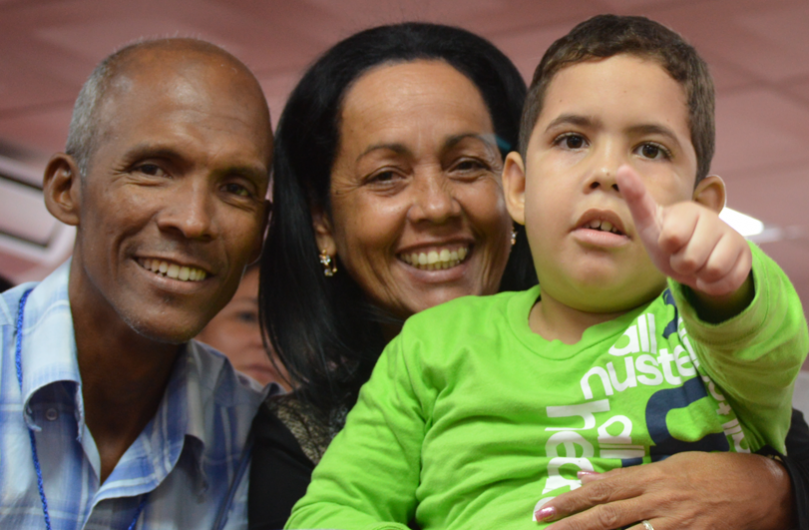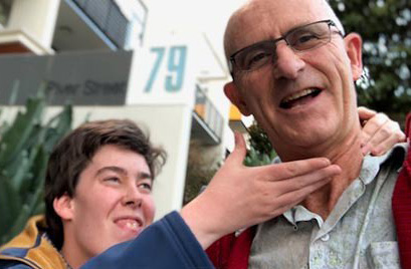A Guide to the Transitional Years
People with Prader-Willi syndrome (PWS) may have great difficulty coping with change!
Planning for change is important to help reduce possible reactive, fearful and oppositional behaviour that can develop as a result of impending change, not just sudden change. Periods of transition can be some of the most stressful and difficult times for people with PWS.
Where possible, accessing transitional planning services can assist the process greatly! The most significant periods of transition for someone with PWS include:
- Starting school as a young child
- Progressing from primary school to high school
- Leaving high school and starting a community or workplace programme
- Moving from the family home into residential care
- And there are times when the job fails the person and another job must be sought
- Experiencing the death of a parent or close family member. Please refer to the following article as this topic is not covered in this article.
Preparing someone with PWS for a major life change takes time, patience and encouragement as well as guidance and direction. Remembering a person with PWS has rigid thinking, it is hard for them to envisage doing something different and can therefore be difficult for them to make choices. Instead they may just decide they don’t want to “do it” or “go there” as a form of reaction to the idea of change. In this article we will focus on Leaving High School and starting a community or workplace programme and Moving from the family home into residential care
What is involved in transition planning?
Each person with PWS is different, with individual capabilities, desires and needs. Some people are able to express their desires and needs better than others, but most people with PWS will need assistance in making appropriate choices, based on their capabilities and their PWS traits.
Three major factors involved in transition planning are:
- A good knowledge and understanding of what the person with PWS is capable of and would like to do
- Providing a PWS safe environment for the person with PWS to ensure as much as possible is done to avoid “failure”. This must include a network of support and backup plans
- Helping the person with PWS adapt to inevitable change
Although it acknowledged that people with PWS usually have difficulty with changes to their routine, they do have individual reactions to change. In any one individual these reactions can also vary over time and be related to the person’s experience.
Parents/caregivers need a good knowledge and understanding of what is available and suitable for their person with PWS before involving them in choices and decision making. Help your person with PWS learn about change by making minor changes to routine, one step at a time. Then involve the person in the process by asking them what alternative things they think should be done by them a choice of two possible alternatives. Praising them for making the decision to change is essential!
Often the person will agree to a change, only to decide they don’t want to do it when the time comes. This could be because they like to say “yes” but haven’t really processed the implications of the change or have not been able to visualise what the change actually means to them. Use visual prompts, social stories or analogies, for example, “Do you remember when we did…well, this is like that” all help them to realise the impending change.
Make sure your anxieties about the change are not reflected in your tone or manner. Keep discussions very matter of fact and calm. However, at times confessing to the person with PWS that you are feeling a little anxious or worried and asking for their suggestions as what to do about this gives them a sense of control and responsibility. This can help them manage the impending change better. Further very good strategies are recommended here.
Starting School
Determining the better school environment for your person with PWS will be dependent on the skills of your child with PWS at that time. Intellectual ability, language and communication skills, social skills and physical skills will be important issues when deciding whether or not to send young child with PWS to a mainstream primary school or a “special needs” primary school if that alternative is available. It may also depend highly on whether your child is eligible for Teacher Aide time – how much and for how long.
Choosing a High or Senior School for your person with PWS will also depend on the above issues, with the addition of the issues of behaviour, food seeking and possibly weight management.
When someone with PWS completes their school years the list of issues to consider grows again.
The most pressing issue is often accessibility to a post school programme of any type, planning for a job, making sure it is the right job and having access to job coaches.
Ideally, the plan is to find a post school programme or a job that is appropriate for someone with PWS.
How to transition plan:
1) At the beginning of your person’s last year of High/Senior School there needs to be a very positive discussion with your person with PWS, about the approaching of adulthood and the eventual need to leave the school environment to commence life in an adult environment. Growing up is exciting!
But, before discussing what they would like to do – it’s best to investigate what opportunities and choices will be available to them. This takes much work on the part of family members, but it is worth the time and effort so you can make possible and appropriate suggestions to your person with PWS. You may find a transitional agency in your community which works with students about to leave school and can provide them with work experience and job coaches
2) It is important to thoroughly determine what services are available and what these services offer. Can they meet the needs and realistic interests of your person with PWS?
Important needs to be met include:
- being occupied, supervision and guidance
- something in which your person with PWS is physically capable of participating something that your person with PWS would be cognitively capable of achieving a food-secure environment or the possibility of creating one
- physical activity during the day
- supervised transport options to and from the program/workplace – especially if in a city environment that involves commuting near shops or food outlets of any type, including local parks
3) Be aware that this transitional phase may include several attempts at finding the right programme, or right job. Be flexible and allow for the ups and downs and ‘speed bumps’ that will undoubtedly get in the way of your young person’s ability to fit into regular life. This is not necessarily an easy time for anyone.
4) Make sure you plan for everything and have a “plan B” for when things don’t go right. Take your time, do not rush, and do be prepared for setbacks.
Don’t be afraid to tell people about PWS
The more the people who are working with your family member know about PWS the better for your person with PWS! Challenge those who are preparing to provide a service for your person with PWS on whether or not they think they can meet the needs of someone with PWS.
Don’t be afraid to ask for what your person with PWS needs
If the service provider has not worked with someone with PWS before, offer to help them learn about PWS by providing information about the syndrome, and also about your family member with PWS. Give the service providers information from the IPWSO website.
Key points to look for, or initiate in a new environment
- Physical accessibility – the environment in which your person with PWS will be working or studying in needs to be safe for them to physically negotiate. Supervised travel must be in place to stimulate punctuality, minimise distraction and prevent food access during travel
- Physical and mental stimulation and occupation – keeping someone with PWS occupied and interested throughout the day is essential to prevent distraction and food seeking. An organised and visual daily schedule will assist the person with PWS to know what is happening each day as well as promote structure in the day. Workplace expectations or “rules” should also be displayed.
- Food security – to reduce food seeking and probable consequences, it is advised to request this before the person starts. Tea rooms, other people’s bags, lolly jars on desks, vending machines and any other source of workplace food/beverage need to be “off limits” and inaccessible to the person with PWS.
- Fares, programme fees, pocket money – need to be pre-organised or planned. Just because your person with PWS is now an adult does not mean that they are responsible for managing their own money.
- Person of reference – people with PWS like to know who is in charge and who they can approach at any time if they have a problem or query. It may not necessarily be the highest person in the environment’s hierarchy, it could be the shift manager or head lecturer – but there needs to be someone who the person with PWS sees as an authority figure. This person or these people need to have a good knowledge and understanding of PWS, based on the information you have supplied.
The top priorities are 1) making the environment PWS appropriate 2) providing a successful experience for your person with PWS.
People with PWS can work or study or be attend community programmes successfully when the transition process is thorough and appropriate. Yes, it involves much preparation and constant monitoring, but the outcome is “success most of the time” which leads to improved self-esteem, good health and well-being.
Where to After School?
The end of school life is a period of great change for any teenager. For those who have PWS this can be a fearful or exciting time as the routine they have known for several years will change. Decisions about their immediate future will need to be made. Parents and the person with PWS will be making decisions about environments and activities that they may have heard of, but will not have experienced, long term, before. It is very important to help them match their desires with their capabilities within appropriate environments.
Transition Planning
Each person with PWS is different, with individual capabilities, desires and needs. Make a list of your son’s or daughter’s likes and dislikes, capabilities and limitations, strengths and weaknesses. Some people are able to express their desires and needs better than others, but most people with PWS will need assistance in making appropriate choices, based on their capabilities and their PWS traits.
Major factors involved in transition planning are:
- Finding out from school or post school, what the process of transition is where you live. It is desirable for a parent or carer to establish through discussions with the school, whether preparation for post-school life is part of the school’s curriculum. Hearing the teacher’s view on the strengths and weakness of your son or daughter will be helpful, even if you do not agree with their opinion.
- a good knowledge and understanding by the parent (or responsible family member) of what the person with PWS know and has experienced of workplaces and day programs. This requires good communication with the school attended.
- endeavouring to find a PWS safe environment for the person with PWS to ensure as much as possible is done to avoid “failure” and loss of self-esteem. This must include a network of support and backup plans including setting up a communication system between you and the workplace / day program staff.
Options for After School
- Employment in a supported environment or “sheltered workplace”
- Day program attendance – that can include development of skills of daily life, community participation, activities and outings. This may be in a group or with an individual carer.
- Employment in an open environment (that is, not specifically for people with disabilities). This is a less common option for people with PWS, but has been achieved.
Many people with PWS are capable of employment; however, some PWS traits may indicate that they will not be immediately successful in a work environment. Other PWS traits positively reinforce their ability to work well in the appropriate environments!
A major difficulty can be finding an appropriate work place for someone with PWS. This can be frustrating for you as parents or family members, as well as for the person with PWS. It can often be all too hard and consequently make the Day Program environment appear attractive if it is easier to source.
Remember many PWS traits are supported by a work environment with repetitive responsibilities, the involvement of manual handling, attention to detail and being occupied by something that will distract then from focusing on food. Such a workplace is perfect for someone with PWS, especially when they receive praise for a job well done. The number of days per week and hours per day need to be negotiated. Some people with PWS will benefit from working shorter hours and fewer days. The number of days or hours worked may need to be altered over the years of the working life of someone with PWS. “Working” helps people with PWS to feel they are part of the community, just like other people!
A parent writes:
Our son works in a place of supported employment. He has been working there for 5 years and is a well-respected employee. This is a “record” length of time that he has worked at the one place. He works 3 consecutive days per week. What makes this place different and successful?
(i) the physical environment: all employees, supported workers and supervisors have a locker into which bags and lunches are placed on arrival at work. The lockers are expected to be locked and prompting to enforce this has rarely been needed.
(ii) the ambience of the work place is a ‘happy’ one, where supervisors and supported workers appear to enjoy their work, taking pride in what they do and what they achieve.
(iii) the hours of work have been negotiable, not only for my son. He works 6 hour days, with other workers employed for shorter or longer days, as required. This is accepted by all workers.
(iv) the work is essentially packing, but the number and type of items to be counted, labelled or packed may vary. (v)there is a designated person to liaise with parents or carers, if or when the need arises.
(vi) there are 3-4 different sections within the workplace where different tasks occur
(vii) all workers are encouraged to be respectful of each other and reminded of this if necessary
(viii) any problems that arise are calmly discussed via phone or in person
Our son, being older, recognises that this is a nice place to work compared to other places because there is genuine respect shown to all workers, problems are dealt with quickly and innovative ways are found to deal with problems.
If a workplace can be found that is, or can be, adapted for people with PWS “work” instead of a “day program” can be very positive for the person with PWS and help them achieve so much more. A sense of purpose and self-esteem are just as important to people with PWS as they are to the ordinary person. They also like the responsibility of work and the feeling of being self-supporting, by earning money.
What contributes to successful employment?
- Step by step training
- Being part of a team
- Not working with food
- No food/drink vending machines
- Job satisfaction
- Repetitive tasks
- Responsibilities
- No accessible food
- Being occupied
- Praise for job competence
- Routine hours
- Respect
- Personal lockers
- Job capability
- Improved self-esteem
If work is considered to be inappropriate for your person with PWS, or suitable work is not available, then a day program should be sourced, or several activities to occupy the person each routinely each day. Unfortunately, many day programs act as a “child minding centre” where PWS-inappropriate practices make up most of the day. Sedentary activities, cooking, independent travel-training, socialising in shopping centres or attending activities that include treat food, do not contribute to a healthy lifestyle for people with PWS. Weight gain and related deterioration of health is seen in too many people with PWS after leaving school and commencing day program attendance. This can be most frustrating for parents and debilitating for the people with PWS. It can also reduce their future work prospects as their fitness decreases. Individual carer day programs can be tailored to suit someone with PWS, but can also feed the self-orientation of people with PWS.
What contributes to successful day programs?
- Social training
- Gym attendance
- Being full occupied
- Taking own food each day
- Good communication with family
- Skills development
- Weekly planner
- Lockable kitchens
- No accessibility to extra food
- Activity-based community work
- Routine hours
- Personal lockers
- Calorie bargaining
- Responsibilities
Transition from one stage of life to the next creates the opportunity for growth, development and improved self-esteem!
This article was written by IPWSO’s Famcare Board.
International Community
IPWSO was established so that PWS associations, families, clinicians and caregivers around the world could exchange information and support and have a united global voice under one umbrella.
Information for Medical Professionals
The latest medical and scientific research and information, plus guides into common medical issues affecting people with PWS.



